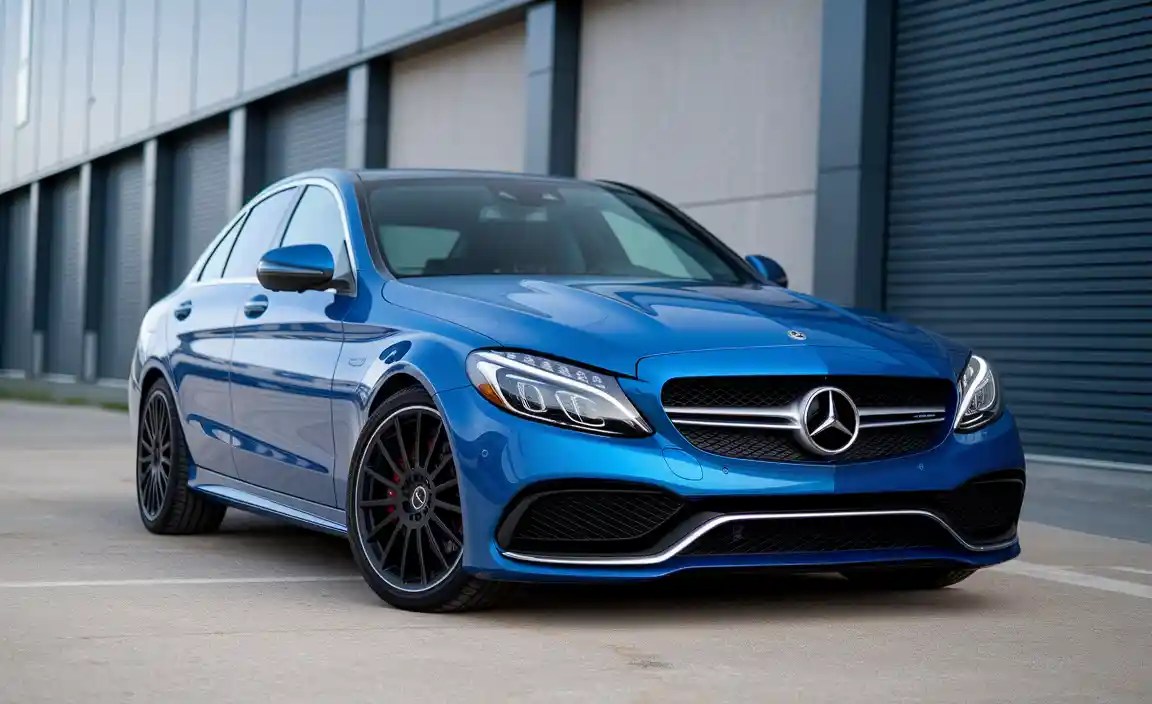Mercedes-Benz C Class Coilover Kit: Ultimate Performance Perfection
A C Class coilover kit replaces your stock suspension with integrated shock and spring units, allowing precise height and damping adjustments. This upgrade enhances handling, reduces body roll, and gives your Mercedes-Benz C Class a sportier stance, offering a noticeable boost in driving enjoyment and performance.
Unlocking Your C Class’s Potential: The Coilover Kit Advantage
Owning a Mercedes-Benz C Class means appreciating a blend of luxury, comfort, and performance. However, for enthusiasts seeking to elevate their driving experience beyond the factory setup, suspension upgrades are a common and rewarding path. One of the most impactful modifications is installing a C Class coilover kit.
Stock suspension is designed for a broad spectrum of drivers and conditions, which can sometimes mean compromises in outright sportiness. If you’ve ever felt your C Class leaning a bit too much in corners, or wished for a sharper, more connected feel to the road, then coilovers might be your answer. This guide is designed to demystify the world of C Class coilover kits.
We’ll break down what they are, how they work, the benefits they offer, and what to consider when choosing and installing one. You don’t need to be a seasoned mechanic to understand this; we’ll explain everything in clear, straightforward terms. Get ready to transform your C Class into a corner-carving machine that still respects its luxurious roots.
What Exactly is a Coilover Kit?
The term “coilover” is a portmanteau of “coil” and “over,” referring to the way the coil spring is mounted directly over the shock absorber. In essence, a coilover kit replaces your vehicle’s separate springs and shock absorbers with a single, integrated unit.
The Anatomy of a Coilover

A typical C Class coilover kit consists of several key components:
Shock Absorber: This is the damper, controlling the oscillation of the spring and dissipating energy from road imperfections. High-quality coilovers feature adjustable damping – often with separate adjustments for bump and rebound.
Coil Spring: This spring supports the weight of the vehicle and absorbs the initial shock of bumps. Coilovers typically use stiffer, shorter springs than stock, contributing to reduced body roll and a firmer ride.
Adjustable Spring Perch: This threaded collar allows for precise adjustment of the vehicle’s ride height. By moving the perch up or down, you can effectively raise or lower the car.
Top Mount: This connects the coilover assembly to the car’s chassis. Performance coilovers often feature camber plates as part of the top mount, allowing for adjustment of the wheel’s camber angle, which is crucial for optimizing tire contact during cornering.
Lower Mount: This attaches the bottom of the coilover to the vehicle’s suspension control arm.

How Do Coilovers Differ from Stock Suspension?
Your C Class likely came equipped with a conventional suspension system where the coil spring and shock absorber are separate components, albeit working together. Stock suspension is engineered for a balance of comfort, durability, and everyday driving dynamics.
Coilovers, on the other hand, represent a performance-oriented upgrade. They offer:
Integrated Design: Combining spring and damper into one unit.
Adjustability: Allowing for fine-tuning of ride height and damping characteristics.
Performance Springs: Typically featuring higher spring rates for improved body control.
Enhanced Damping: Often using more sophisticated internal valving for better control.
Why Upgrade to a C Class Coilover Kit? The Performance Benefits

Switching to a C Class coilover kit is more than just an aesthetic modification; it’s a functional upgrade that can significantly enhance your driving experience. The primary goal is usually to achieve “ultimate performance perfection,” and coilovers are a key ingredient.
1. Improved Handling and Cornering
This is the most significant advantage. Coilovers allow for:
Reduced Body Roll: Stiffer springs and a lower center of gravity minimize the lean your C Class exhibits when cornering. This translates to a more stable and planted feel.
Sharper Steering Response: With less body roll and often adjustable camber, your steering inputs become more direct and immediate.
Better Tire Contact: Optimal suspension geometry, especially with adjustable camber, ensures your tires remain in better contact with the road surface during dynamic driving, maximizing grip.
2. Adjustable Ride Height
Coilover kits offer the ability to dial in your desired ride height. This is beneficial for several reasons:
Aesthetics: Lowering your C Class gives it a more aggressive, sporty stance that many enthusiasts desire.
Performance: A lower center of gravity further reduces body roll and improves handling. It can also help reduce aerodynamic drag at higher speeds.
Practicality: While lowering, you can still maintain a reasonable balance to avoid excessive scraping on everyday roads, depending on how low you set it.
3. Customizable Damping (The “Perfect” Ride)
Many performance C Class coilover kits feature adjustable damping. This allows you to tailor the stiffness of the ride to your preferences and driving conditions.
Softer Settings: For comfortable daily driving, absorbing road imperfections more smoothly.
Stiffer Settings: For spirited driving on twisty roads or track days, providing maximum control and feedback.
This adjustability is where the “ultimate performance perfection” truly comes into play, allowing you to fine-tune the car’s behavior.
4. Weight Reduction
While not the primary goal, some coilover units can be lighter than the stock separate spring and shock absorber assemblies, contributing slightly to reducing the vehicle’s overall weight.
Choosing the Right C Class Coilover Kit for Your Needs

The market offers a wide array of C Class coilover kits, varying in price, features, and intended use. Making the right choice ensures you get the performance you desire without compromising too much on comfort or reliability.
Key Factors to Consider
Brand Reputation and Quality: Opt for reputable brands known for their engineering, materials, and customer support. Look for brands that have a strong presence in Mercedes-Benz tuning.
Adjustability Features:
Ride Height: Most coilovers offer this. Ensure the adjustment range meets your expectations.
Damping: Single-way, two-way, or even three-way adjustable damping offers granular control but also increases complexity and cost. For most beginners, single-way (adjusting rebound or a combined bump/rebound) is sufficient.
Camber Plates: If you plan on aggressive alignment for track use, integrated camber plates are a significant advantage.
Spring Rates: These determine how stiff the suspension is. Higher spring rates offer better control but a firmer ride. Manufacturers usually offer different spring rate options or recommend rates based on your driving style (street, track, etc.).
Intended Use:
Street Performance: A balance of improved handling and acceptable comfort.
Track/Track Day: Prioritizes maximum grip and adjustability, often with a firmer ride.
Show/Stance: Focuses heavily on achieving a specific low look, often with less emphasis on ultimate track performance.
Budget: Coilover kits can range from a few hundred dollars to several thousand. Invest in the best quality you can afford, as a cheap, poorly made kit can be detrimental.
Compatibility: Ensure the kit is designed specifically for your Mercedes-Benz C Class model year and variant (e.g., W205, W206, Sedan, Coupe).
Top Brands to Consider (Examples)
While specific models change, here are some well-regarded brands in the performance suspension market that often produce C Class coilover kits:
KW Automotive: Known for their V1, V2, V3, and Clubsport lines, offering various levels of adjustability and performance.
Bilstein: Famous for their B14 (PSS) and B16 (PSS9/PSS10) kits, providing excellent damping control and durability.
H&R: Offers high-quality suspension components, including street-performance coilover kits.
BC Racing: Popular for their BR Series, offering a good balance of adjustability, performance, and value.
Ohlins: Premium option, often found on high-end performance vehicles, offering top-tier damping technology.
It’s always advisable to research reviews and forum discussions specific to your C Class model and the coilover kits you are considering.
Installing a C Class Coilover Kit: A Step-by-Step Overview

Installing coilovers is a moderately challenging DIY project. If you’re not comfortable working with suspension components, it’s best left to a professional mechanic or a specialized tuning shop. Incorrect installation can lead to safety issues and damage.
Disclaimer: This overview is for informational purposes only. Always refer to the specific installation manual provided with your coilover kit and consult a qualified professional if you have any doubts. Ensure you have a safe and level working environment.
Essential Tools and Equipment
Jack and Jack Stands (high quality and properly rated)
Lug Wrench
Socket Set (metric)
Wrench Set (metric)
Torque Wrench
Spring Compressors (if required for your kit)
Pry Bars
Wire Brush
Penetrating Oil (e.g., WD-40)
Gloves and Safety Glasses
Floor or Trolley Jack
Possibly a 3/8″ or 1/2″ Drive Ratchet and Extension
Installation Steps (General Guide)
1. Preparation:
Park the car on a level, solid surface.
Engage the parking brake firmly.
Loosen the lug nuts on all wheels before jacking up the vehicle.
Gently spray penetrating oil on any bolts or nuts that might be seized.
2. Jack Up the Vehicle:
Using your floor jack, lift the front or rear of the vehicle and securely place jack stands under the designated support points.
Never work under a vehicle supported only by a jack.
Repeat for the other end of the vehicle.
3. Remove Wheels:
Finish loosening and remove the lug nuts, then carefully remove the wheels.
4. Remove Stock Suspension:
Front: Typically involves disconnecting the sway bar end link, unclipping brake lines and ABS sensor wires, unbolting the strut from the steering knuckle, and unbolting the strut tower bolts from the top of the engine bay. You might need to remove the hood cover or other components to access the top mounts. Some kits may require compressing the spring on the stock strut before removal to relieve tension.
Rear: Usually involves disconnecting the sway bar end link (if applicable), unbolting the lower shock mount, unbolting the upper shock mount, and then carefully maneuvering the old strut assembly out. You may need to detach control arms or other suspension components to gain clearance.
5. Assemble and Install Coilovers:
Follow your coilover kit’s instructions precisely for assembly. This may involve transferring top mounts (if not included) or setting initial ride height and preload (if applicable – some performance kits have specific preload requirements, others set initial height and then pre-load).
Important Note: Many modern performance coilovers are designed to be installed with zero preload on the spring. The spring should be seated but not under compression before it’s installed. Always verify with your kit’s manual.
Install the new coilover units, working in reverse order of removal.
Torque Everything: Crucially, torque all bolts and nuts to the manufacturer’s specifications using a torque wrench. Improperly torqued suspension components are a major safety hazard. Refer to your C Class’s service manual for factory torque specs, or the coilover manufacturer’s recommendations if they differ.
6. Set Initial Ride Height:
Adjust the spring perches to achieve your desired ride height. It’s recommended to set the front and rear to within a reasonable range of each other initially.
Aim for roughly equal ride height adjustments across the front and rear axles, and apply this adjustment equally to all sides (left front, right front, etc.) unless you’re intentionally setting a rake.
Remember that ride height will settle slightly after installation.
7. Reinstall Wheels and Lower Vehicle:
With the wheels loosely reinstalled, carefully lower the vehicle off the jack stands.
Tighten the lug nuts in a star pattern to the vehicle manufacturer’s specified torque.
8. Post-Installation Checks & Alignment:
Critical: After installing coilovers and making height adjustments, your car’s alignment will be significantly affected, especially camber and toe.
Take your C Class to a reputable alignment shop immediately.
Discuss your desired alignment settings with the technician. For street use, a mild performance alignment is usually best. Camber plates allow for performance alignment adjustments, but too much negative camber can cause premature tire wear on a daily driver.
Most coilover kits recommend driving for a short period (50-100 miles) and then re-torquing all suspension bolts before a final alignment.
Fine-Tuning Your C Class Coilover Setup
Once your coilovers are installed and aligned, the real magic of “performance perfection” begins with fine-tuning. This is where you tailor the suspension to your exact preferences.

Understanding Damping Adjustments
If your C Class coilover kit has adjustable damping, here’s a basic guide:
Bump Damping: Controls how the suspension reacts to upward movement (hitting a bump).
Rebound Damping: Controls how the suspension extends after being compressed (coming off a bump).
Most commonly, you’ll find knobs or screws that adjust one or both. Numbers on the adjuster typically indicate stiffness (e.g., 1 being softest, 10 being firmest).
General Tuning Strategy:
1. Start Soft: Begin with the damping adjusters set to their softest settings (or somewhere in the middle if you’re unsure).
2. Test Drive: Drive your car on a familiar road. Pay attention to how it feels over bumps, in corners, and during braking/acceleration.
3. Adjust Incrementally:
Too Bouncy/Uncontrolled: Increase rebound damping.
Too Harsh/Jolting: Decrease bump damping.
Excessive Body Roll: You might need stiffer springs (which require replacing the entire spring/perch assembly), or you may have the damping set too soft.
Bottoming Out: Increase bump damping or ride height.
4. Listen to Your Car: Adjustments are often subtle. Make one click at a time on each adjuster and test extensively.
5. Consider Both Ends: Adjustments to the front will affect the rear, and vice-versa. Work on one axle at a time, or adjust both front and rear similarly.
Refer to your specific coilover manufacturer’s guide for detailed instructions on their damping adjustment system.
Ride Height Tuning
Lowering Too Much: Can lead to scraping, poor suspension travel, and clearance issues with tires and bodywork. It also significantly alters suspension geometry.
Finding the Sweet Spot: For a balance of looks and function, a drop of 1-1.5 inches is often a good starting point. Many enthusiasts aim for a stance where the wheel gap is reduced, but the car still has enough clearance to navigate most roads without constant concern. A common goal is to have the top of the tire sit just below the fender arch.
Remember, ride height adjustments alter suspension geometry. Excessive lowering without addressing these changes (e.g., via alignment or specific suspension links) can negatively impact handling and tire wear.
Troubleshooting Common Coilover Issues
Even with high-quality kits, issues can arise. Being aware of them can help you address problems quickly.
Common Issues and Solutions
| Issue | Possible Cause | Solution |
| :——————— | :—————————————————————————– | :———————————————————————————————————————————– |
| Clunking/Knocking | Loose bolts, worn bushings, improperly installed top mounts, damaged components. | Re-torque all suspension bolts. Inspect bushings for wear. Ensure top mounts are correctly seated and secured. Check for damage. |
| Bouncing/Pogo Effect | Incorrect damping settings (usually rebound too soft), worn damping, mismatched springs. | Increase rebound damping. If persistent, consult manufacturer or check for internal damper issues. Verify spring compatibility. |
| Harsh Ride | Damping set too stiff, spring rates too high for intended use, incorrect tire pressure. | Soften damping. Consider softer springs if appropriate, or review your intended use vs. the kit’s specs. Verify tire pressures. |
| Uneven Ride Height | Inconsistent spring perch adjustments, settling, worn springs. | Re-measure and adjust spring perches for parallelism and desired height. Some settling is normal; re-adjustments may be needed. |
| Premature Tire Wear | Aggressive alignment (camber/toe), incorrect ride height, worn components. | Consult an alignment shop for suitable street/performance settings. Re-evaluate ride height for optimal geometry. Inspect suspension. |
| Leaking Shocks | Seal failure, physical damage to the shock body. | This typically requires rebuilding or replacing the coilover unit. Contact the manufacturer. |
Always consult the coilover manufacturer’s support or a qualified technician if you’re unsure about diagnosing or fixing a problem.






